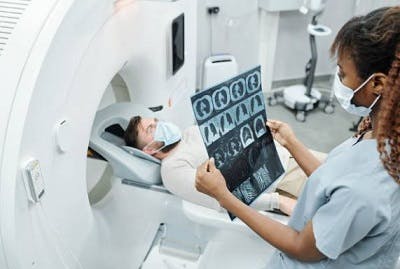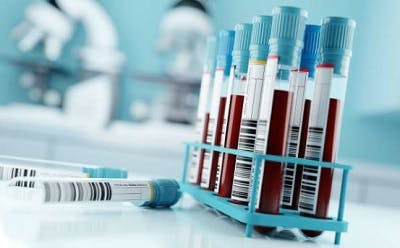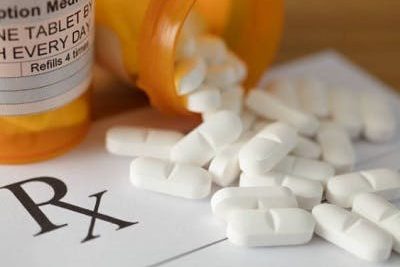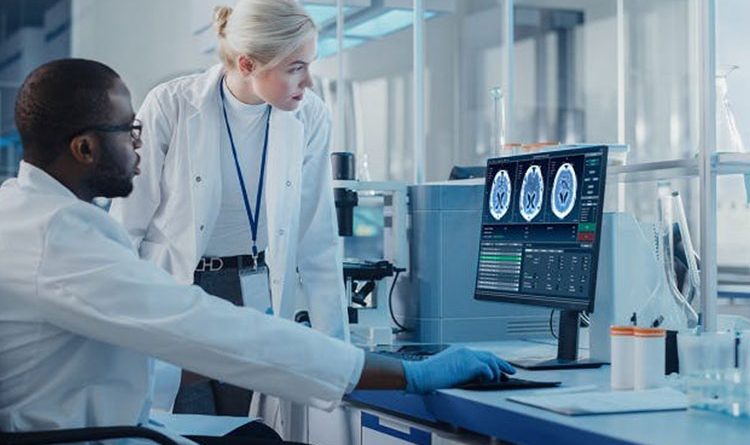How Is a Stroke Diagnosed? Understanding the Evaluation Process
Because a stroke is complex and multi-faceted, individuals may wonder, how is a stroke diagnosed? Learning how a stroke is diagnosed can help you and your loved ones understand what is happening in the hospital in the case of an event.
This article will discuss potential exams used to diagnose a stroke, early warning signs, and most effective treatments for the best functional outcome.
What Is a Stroke?
A stroke is caused by a blockage or interruption of blood flow within the brain. There are two types of stroke. An ischemic stroke occurs when an artery becomes blocked by a blood clot, while a hemorrhagic stroke occurs when an artery in the brain ruptures. A stroke is a medical emergency that requires swift treatment because brain cells require oxygen-rich blood in order to function and survive.
Every stroke is different, and every survivor may feel different stroke symptoms. However, there are common symptoms of a stroke that every individual should know.
Early warning signs of a stroke include:
- Dizziness accompanied by loss of balance and coordination
- Vertigo (sudden spinning sensation)
- Confusion
- Difficulty speaking or understanding spoken language
- Sudden vision problems (in one or both eyes)
- Severe headache (with no known cause)
- Sudden numbness or weakness
When identifying a stroke, be sure to act F.A.S.T. and follow these steps:
- Face: Check to see if one side of the face droops by asking the individual to smile.
- Arms: Check to see if one arm drifts downward by asking the individual to raise both arms.
- Speech: Check to see if the speech is strange or slurred by asking the individual to repeat a simple phrase.
- Time: Check to see if the individual presents any of these signs and seek immediate help! Call 9-1-1 right away.
Do not drive to the hospital if you are experiencing any of these symptoms or let your loved one drive alone during this life-threatening emergency. Call for an ambulance and medical personnel will assist you.
Certain risk factors increase the chances of having a stroke, such as hypertension and smoking. However, the risk factors may not necessarily be the direct cause of the stroke. To obtain a proper diagnosis and treatment, doctors need to assess and perform a variety of exams. This may include both imaging and blood tests.
How Do You Diagnose a Stroke?
Your doctor will order a variety of tests to help diagnose the stroke and rule out other possible health conditions with similar signs or symptoms. Usually, after gathering general information from you or your loved one, a CT scan or MRI of the brain is the first test performed. However, there are many other exams that can be used to further determine the location of the injury and severity.
The sooner these tests are done, the sooner your doctor can initiate treatment, which is crucial to minimize brain damage and potential effects.
Tests Used to Diagnose a Stroke

Doctors may look at a combination of data including tests, symptoms, and medical history to identify the type of stroke and, more specifically, which area of the brain is affected.
Tests used to diagnose a stroke can include:
Physical Exam
One of the first tests given is a physical exam. During the exam, your doctor will check to see what symptoms you present with such as confusion, lack of coordination, weakness, numbness, and difficulty speaking. Doctors will also check your blood pressure and listen to your heart. They may also use their stethoscope at the side of your neck to listen for a whooshing sound called a carotid bruit, which can suggest reduced or changes in blood flow due to plaque buildup.
Neurological Exam
Along with a physical exam, your doctor will also provide a neurological exam in order to test your central nervous system. Your doctor may ask you to perform simple tasks to test your reflexes, where each task tests a different part of your brain. This helps determine the severity of the stroke and the possible location of the injury.
Medical History
Checking medical history is more similar to a questionnaire than an exam. However, it is equally as helpful. It’s important for doctors to know any stroke history as well as any preexisting medical conditions that run in the family. When reviewing past symptom history, your doctor will also ask for a list of any current medications you are taking to determine the cause of your symptoms.
Swallow Tests
Swallow tests may be given soon after a stroke diagnosis. This is used to test the ability to swallow properly, which is important because difficulty swallowing increases the risk of having food or drink enter the lungs (aspiration). When this occurs, it can lead to infections such as pneumonia.
To perform a swallow test, doctors start by asking the survivor to drink a few teaspoons of water. If they are able to swallow without choking or coughing, they may be given half a glass of water. If the test indicates that the survivor struggles with swallowing food or water, they will be referred to a speech-language pathologist for a more detailed assessment and therapy plan.
Imaging Tests Used to Diagnose a Stroke

Brain scans are needed to determine the type of stroke and help doctors provide swift, proper treatment. Individuals experiencing stroke symptoms typically require some type of brain scan within the first hour of emergency care at the hospital. It’s especially important for survivors who are presenting a lower level of consciousness or are receiving anticoagulant treatments.
Computed Tomography (CT) Scan
A CT scan is among the most common ways to diagnose a stroke. This exam is used to diagnose various medical conditions, including tumor, bleeding in the brain, and ischemic stroke. This scan uses multiple x-ray images to create a detailed 3-dimensional picture of the brain.
A CT scan is usually one of the first tests performed because, with clear images of the brain, doctors can identify any abnormalities or other problems causing stroke-like symptoms.
Magnetic Resonance Imaging (MRI)
An MRI is a test that uses radio waves and a magnetic field to create detailed images of the brain and other parts of the body. This imaging exam can detect changes in brain tissue or damage to the brain cells caused by hemorrhages or blockages, at a quicker rate than a CT scan.
While this test is usually given to individuals with complex symptoms, it’s often used with a CT scan for a more accurate stroke diagnosis.
Cerebral Angiogram
A cerebral angiogram is a medical test that’s performed with a series of x-rays to produce images of the blood vessels within the brain. A dye is injected into the veins to help show a detailed image of the blood vessels, which can help doctors confirm abnormalities in the brain, like a blood clot, and diagnose a stroke. You can think of it as an x-ray movie of the blood vessels along with a visual of the blood flow.
Magnetic Resonance Angiogram (MRA)
Similar to a cerebral angiogram, a magnetic resonance angiogram allows doctors to see the blood vessels in the brain (or other body parts). This allows them to determine whether there is any narrowing of the arteries, clot formation, or other abnormalities. An MRA may be preferred to a cerebral angiogram by some doctors as it is less invasive.
Echocardiogram (ECG)
An echocardiogram uses sound waves to create a detailed image of your heart, and is usually done by moving an ultrasound probe across your chest (transthoracic ECG). It’s used to find a source of clots in the heart that may have traveled to the brain and potentially caused a stroke.
An alternative type of an ECG is a transesophageal echocardiography (TOE) where an ultrasound probe slides down the esophagus while the individual is sedated. The probe is placed directly behind the heart to produce a clear image of any blood clot or abnormalities that were difficult to see in a transthoracic ECG.
Electrocardiogram (EKG)
An electrocardiogram is a different way to diagnose a stroke in that it checks the electrical activity of the heart, which can help determine any possible heart problems that may have caused a stroke. It can also help detect atrial fibrillation or previous heart attack that may have contributed to a stroke.
Electroencephalogram (EEG)
An electroencephalogram is a less common type of exam that places electrodes on your head with wires connected to a machine. This machine records the electrical activity in the brain which can help rule out seizures. Seizures can cause similar symptoms of a stroke, such as confusion and difficulty with movement. Therefore, to diagnose a stroke, other conditions must be ruled out first.
Carotid Ultrasound
A carotid ultrasound scan is another type of test (usually done within the first 48 hours) that can help diagnose a stroke. It uses a small probe that sends high-frequency sound waves into your body. When the sound waves bounce back, they can help create an image of the inside of the carotid arteries in the neck, which supply blood to the brain.
Studies show that approximately 75% of all ischemic strokes occur in the carotid arteries in the neck. This test also shows blood flow in the arteries or any buildup of plaque (fatty deposits). This test is often accompanied by a CT scan or MRI angiogram.
Trans-Cranial Doppler (TCD) Ultrasound
Doctors may also use a trans-cranial doppler to diagnose a stroke caused by blood clots, narrowed blood vessels, or other conditions. This ultrasound uses sound waves to measure blood flow and it also helps locate which artery contains the blood clot.
Lumbar Puncture (Spinal Tap)
A lumbar puncture, also known as a spinal tap, is used when the imaging tests do not detect any bleeding in the brain but there is still some suspicion of a hemorrhagic stroke. Doctors will use a needle to collect fluid from your spinal cord. The fluid will then be tested for various substances in the blood.
Blood Tests Used to Help Diagnose a Stroke

A variety of blood tests may be performed while you are in the hospital. While blood tests alone cannot diagnose a stroke, they are very helpful in identifying the cause of your stroke symptoms. Different blood tests may check to see how quickly or slowly the blood is clotting, if there is any muscle damage, if sugar or cholesterol levels in the blood are too high or low, and if you have any infections present.
Doctors may order a specific set of blood tests to evaluate the distribution of blood cells, the number of platelets, and the levels of various substances in the blood. This can help them determine whether you are stable or need medication.
Blood tests used to diagnose a stroke include:
Complete Blood Count (CBC)
A complete blood count test is used to measure the health of your blood cells. It helps detect infection, clotting, anemia, and other potential health issues.
Thyroid
A blood test may be given to test your thyroid hormone levels. This is important because hyperthyroidism can lead to atrial fibrillation, which can increase your risk of stroke.
Glucose (Sugar) and Cholesterol
Blood tests can also measure your glucose and cholesterol levels. Abnormal levels of either can contribute to leading causes of stroke, such as diabetes and hypertension.
C-reactive Protein
Another substance that doctors will look for in blood tests is c-reactive protein, which is an indicator of inflammation or swelling in the body. This can further indicate if there’s damage within the arteries, which can be a potential cause of stroke.
Serum Electrolytes
The blood carries electrolytes, which help maintain the balance of fluids, regulate muscle contractions, and help you stay hydrated. An imbalance of electrolytes can cause stroke-like symptoms such as muscle weakness and confusion.
Treatment After a Stroke Diagnosis

After exams have been conducted and a stroke diagnosis has been provided, treatment can begin. Immediate stroke treatment is essential to stabilize the survivor, restore blood flow, and reduce the risk of disability.
If an ischemic stroke diagnosis was given, the individual may need a clot-busting drug to dissolve the clot and restore blood flow in the brain. This can include medication such as the tissue plasminogen activator (t-PA), which is usually administered intravenously within the first few hours of stroke onset. When t-PA cannot be prescribed, doctors may recommend blood-thinners such as warfarin and aspirin to help thin the blood.
Other ischemic stroke treatments may include endovascular therapy, which is a minimally invasive procedure used to improve blood flow within the arteries of the brain. Devices such as balloons and stents help open up narrowed blood vessels.
Treatment for a hemorrhagic stroke usually requires surgery to stop the bleeding in the brain and relieve any excess intracranial pressure. For example, a craniotomy may be performed where surgeons remove part of the skull to reduce intracranial pressure and treat the ruptured artery.
After a stroke has been diagnosed and treated, the road to recovery begins. Survivors will engage in rehabilitation to help manage any secondary effects they experience, such as weakness on one side of the body.
Rehabilitation can include a variety of therapies such as physical and occupational therapy to help address any motor difficulties or speech therapy to improve speech and swallowing after a stroke. Continued focus on rehabilitation at home after discharge from inpatient and outpatient therapies is essential to encourage the brain to continue healing for as long as possible.
Understanding How a Stroke Is Diagnosed
Understanding how a stroke is diagnosed can help you and your loved ones know what to expect in the case of an event. Proper treatment depends on an accurate diagnosis. Therefore it’s essential to seek emergency medical care where doctors can perform a variety of exams, including imaging and blood tests. Once a stroke has been diagnosed and treated, recovery can begin.
Keep It Going: Download Our Stroke Recovery Ebook for Free

Get our free stroke recovery ebook by signing up below! It contains 15 tips every stroke survivor and caregiver must know. You’ll also receive our weekly Monday newsletter that contains 5 articles on stroke recovery. We will never sell your email address, and we never spam. That we promise.
